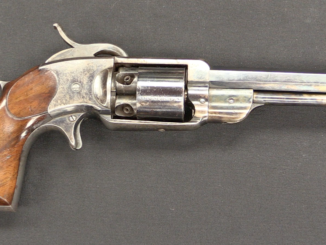Today I am out at the range with Matt Haught from Sym-Tac to test out our original WW1 Winchester 1897 Trench Gun with some original WW2 GI buckshot. While the US did buy some shotgun ammunition specially packaged for military use, the majority was simply commercial off-the-shelf ammunition stamped “US Property”. We are using a box of that type of US Property Remington Kleanbore, 9-pellet 00 buckshot. In addition, we will testing premium modern Federal Flite Control buckshot in the trench gun, and also test both in a modern SymTac 870 from Vang Comp.
To both my and Matt’s surprise, this trench gun patterned fantastically well with both types of ammunition!



day in day out them being wet they would eventually fail. poor soldiers.
“(…)wet(…)”
If this is concern then use M19 https://sharky-fourbees.blogspot.com/2016/05/us-military-ww2-shotgun-shot-shells-m19.html
Everything is a tradeoff until it isn’t. Today’s buckshot shells are optimized for, well, buck – despite home defense far outpacing hunting as a percentage of shooters, and buckshot-only deer jurisdictions gradually disappearing one way or the other.
Given a home defense scenario and a fixed volume, I’d much prefer more room for shot over buffering for a tight 35yd (a range I can’t imagine defending in court) pattern.
I think the slow reload might make the choice for fighting in a zig-zag trench a little less clear.
During the century or so when repeating shotguns were among the more commonly used gun-fighting weapons in the USA, it was found that in short-duration, limited range firefights, the shotgun would fire several shells, and then get “topped up” by putting shells into the tube magazine with the shotgun shouldered, trigger hand ready to go, and this would work OK.
Also, if a shotgun goes dry, you can always pop a shell into the ejection port, close the breech, and have a shell ready to go as you load the tube magazine.
Whether or not this is how shotguns may have been handled in WWI is anyone’s guess, or subject to further research. The prospect of fumbling with a shell extracted from a uniform pocket with numb, cold, muddy hands certainly sounds like a recipe for fumbling, but then again, handling a five-round charger/ “stripper clip” for a 1903 or 1917 is a similar prospect, no?
It’s the ammunition!
I remember using paper shotgun shells prior to 1965. I wasn’t fully literate at the time, just learning to read and write, so I don’t know the exact dates–but the unique sent of the impregnated paper hulls is still recognizable. Those paper shotgun shells had some sort of paraffin infused into the outer paper and under very hot conditions this could affect the powder charge–it wasn’t just moisture that affected these waterproof shells. Most of the paper shotgun shells I remember had a roll crimp and a cardboard disk over the shot. There were some star crimped paper shotgun shells. I fired mostly .410 but there was a 16 gauge in the house and other hunters used 20 gauge and 12-gauge paper shotgun shells. Modern ammo is far superior.
The definition of “effective range” has evolved. It used to be tagging a human adversary with one buckshot pellet was “effective,” just has the .25 ACP was regarded as a viable defense option once upon a time. Now the dogma is that every pellet has to hit and stay in the torso. A five-pellet #000 buckshot load fired at lower velocity from a .410 is “superior” to a 15-pellet #00 buckshot load fired from a 12-gauge 3″ with 50% more 12-gauge velocity when four of the .410 buckshot hit but “only” eight of the 12-gauge load hits at 25 yards distance. Dogma isn’t reality.
It was still startling that Ian demonstrated the cylinder bore shotgun outshooting a tricked out modern gun in terms of pattern tightness. Thanks for objective testing at 10 yards and at 25 yards. I’m not sure if the 50-yard spread was 8 foot in WWI–that sounds more like 100 yards 12-gauge #00 buckshot spread. Modern plastic shotgun shells are cost-effective, work better than paper shells and are more economical than all brass or even USAF-issue all-aluminum .410 shells with #6 shot…
No remarks on how different the vintage paper shotgun shells smelled when fired versus the new plastic ammunition.
The War Dept. should and could have bought all brass hulls from the beginning, and hang the cost.
Should have? Yes.
Could have? Congress had the final say on that.
Incidentally, in 1940 the British Home Guard were issued “12-bore” shells, loaded with 00 buckshot to “repel” German paratroopers. Similar ammunition was later issued to combat troops armed with Browning Automatic-5 shotguns during the Malayan Emergency.
The Local Defence Volunteers, and later, the Home Guard, were issued
“Broad Arrow”-marked shot shells for use with civilian shotguns. Some were “SG” with 9 00 buckshot. Other shot shells were “LG” or eight No. 0 buck (about .36 cal.).
There was also a load called “shrapnel ball” that was designed for use in any shotgun, including those with full chokes. This was a .50 caliber lead ball, aka the American-type “punkin ball”.
Most of these were medium to high brass paper shells.
In India, guards at camps for Japanese POWs were often issued single-shot Martini-action 10-gauge riot guns, converted from .577/.450 rifles;
https://www.gunsinternational.com/guns-for-sale-online/shotguns/antique-shotguns—cartridge/british-martini-henry-smoothbore-riot-gun.cfm?gun_id=101053654
Due to the climate, they were issued with locally-made all-brass 10-gauge rounds, containing 16 00 buckshot or 12 No. 0. These also carried the Broad Arrow mark.
cheers
eon
“best patterning from a Model ’97 I’ve ever seen…”
Follow up to look the barrel over in a lab, I suppose?
Gotta love that some ancient century-old cylinder bore Winchester barrel threw non-buffered, non-plated double aught buck and supercalifragilisticexpialidocious flite-control (TM) into a tighter pattern than a Vang-comp ported barrel! Ha-ha!
“What have we gained?” and at “what expense?” one may wonder?
Quale tipo di polvere e che carica avevano le cartucce usate nel video ?